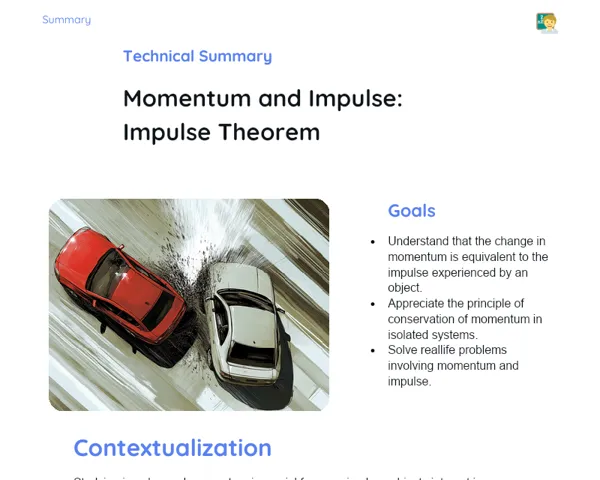Summary Tradisional | Electricity: Electrical Circuits
Contextualization
Electricity is a vital part of our everyday lives in India, woven into nearly every aspect of modern living. From powering our homes to operating computers and smartphones, electricity is omnipresent. Electric circuits are the frameworks that allow us to harness and utilize electricity in a controlled and safe manner, ensuring that devices work efficiently and energy is distributed effectively. Grasping the fundamentals of electric circuits is essential to understand how electricity serves various functions and how we can troubleshoot related issues.
Electric circuits are composed of several components like resistors, capacitors, voltage sources, and switches, each tasked with regulating the flow of electric current. Electric current denotes the movement of electric charges through a conductor, propelled by a potential difference, or voltage. Electric resistance refers to the hindrance to current flow within a material. Familiarity with these principles is crucial for addressing electric circuit issues, a critical skill for both physics education and practical applications in engineering and technology.
To Remember!
Electric Current
Electric current is essentially the movement of electric charges through a conductor, commonly a metallic wire. These charges are typically electrons that travel from a region of lower electric potential to one of higher potential. Electric current is quantified in Amperes (A), indicating how much charge passes a point in the circuit every second. The conventional direction of current flows from the positive terminal to the negative terminal of the power source, although in reality, electrons flow in the opposite direction.
The strength of the electric current in a circuit is influenced by two main elements: the voltage applied across the circuit and the resistance within it. According to Ohm’s Law, current (I) equals voltage (V) divided by resistance (R): I = V/R. Thus, for a given voltage, increased resistance results in diminished current, and vice versa.
We generally deal with two types of electric current: direct current (DC), where electron flow is unidirectional, and alternating current (AC), where the electron flow reverses periodically. DC is typically found in batteries, while AC is the norm in power supply systems delivering electricity to our homes and industrial settings.
-
Movement of electric charges through a conductor.
-
Measured in Amperes (A).
-
Dependent on the circuit's voltage and resistance.
Potential Difference (Voltage)
Potential difference, or voltage, is essentially what pushes electrons through a circuit. It is generated by power sources like batteries or electrical outlets. Voltage is measured in Volts (V) and is crucial for electric current flow, as it provides the energy required to drive electrons against the circuit's resistance.
In practical terms, voltage can be likened to pressure in a water supply system. Just as pressure makes water travel through pipes, voltage prompts electrons to flow through a conductor. Voltage can be constant, as seen in batteries (direct voltage), or fluctuate periodically, as is the case with electricity supplied by power grids (alternating voltage).
A voltmeter is used to measure voltage between two points in a circuit. In series circuits, the total voltage is the sum of voltages across individual components. In parallel circuits, all components experience the same voltage equal to the source voltage.
-
The force that propels electrons through a circuit.
-
Measured in Volts (V).
-
Can be either direct or alternating.
Electrical Resistance
Electrical resistance is the resistance to current flow within a material, caused by the collisions between moving electrons and the atoms in the conductor. Resistance is gauged in Ohms (Ω). A material's resistance is influenced by factors such as its length, thickness, material type, and temperature.
Ohm’s Law articulates the relationship between voltage (V), current (I), and resistance (R) in a circuit: V = IR. This indicates that at a constant current, voltage will increase alongside resistance. In simpler terms, higher resistance demands higher voltage to maintain the same current. Devices like resistors are integrated into circuits to manage the flow of current effectively.
The overall resistance in a circuit varies based on how resistors are configured. In a series circuit, resistances accrue. Conversely, in a parallel circuit, the total resistance is less than the resistance of the lowest individual resistor, owing to multiple current paths. Understanding resistance is pivotal to circuit design, allowing for precise control of both current and voltage.
-
Resistance to current flow in a material.
-
Measured in Ohms (Ω).
-
Described by Ohm's Law (V = IR).
Kirchhoff's Laws
Kirchhoff's Laws are essential for deconstructing complex electric circuits. They encompass two primary laws: Kirchhoff's Current Law (KCL) and Kirchhoff's Voltage Law (KVL). KCL asserts that the total current flowing into a junction is equivalent to the total current flowing out, based on the conservation of electric charge.
KVL states that in any closed circuit loop, the sum of voltages equates to zero, adhering to the conservation of energy principle. In a closed loop, the energy provided by voltage sources matches that dissipated by resistors and other components.
These laws are critical for untangling intricate circuits with various series and parallel arrangements. They facilitate the calculation of unknown voltages and currents at any segment of the circuit. Employing Kirchhoff's Laws involves writing equations based on these principles and solving sets of linear equations.
-
KCL: Sum of currents at a junction is equal.
-
KVL: Sum of voltages in a closed loop equals zero.
-
Crucial for analyzing complex circuits.
Key Terms
-
Electric Current: Movement of electric charges through a conductor.
-
Potential Difference (Voltage): Force driving electrons through a circuit.
-
Electrical Resistance: Opposition to current flow in a material.
-
Ohm's Law: Relation between voltage, current, and resistance (V = IR).
-
Kirchhoff's Laws: Fundamental rules for analyzing complex electric circuits.
Important Conclusions
In this session, we delved into the core principles of electric current, potential difference (voltage), and electrical resistance, all of which are vital for comprehending electric circuits. We discussed the interrelations of these concepts as well as their practical applications, utilizing Ohm's Law and Kirchhoff's Laws for solving circuit problems, both simple and complex. Mastery of these principles is significant not just for the discipline of physics but also for practical applications in engineering, technology, and our everyday interactions with electrical systems.
Moreover, we examined various types of electric circuits including series and parallel arrangements, and learned the techniques required to calculate the electric parameters associated with these configurations. The capability to troubleshoot electric circuits is an invaluable skill applicable across domains, from the maintenance of electronic devices to the engineering of intricate electrical systems.
Lastly, we reiterated the significance of Kirchhoff's Laws in analyzing complex electrical circuits, enabling precise evaluation of currents and voltages throughout the circuit. This foundational knowledge is critical for students aiming to pursue careers in fields where electricity holds a pivotal role. We encourage learners to keep exploring these concepts, apply their understanding in real-world scenarios, and advance their knowledge of electricity and electric circuits.
Study Tips
-
Review the examples and exercises discussed in class, practicing the use of Ohm's Law and Kirchhoff's Laws across various electric circuit types.
-
Utilize online electric circuit simulators to visualize circuit behaviors and experiment with different component configurations.
-
Further your reading by exploring additional chapters on electricity and electric circuits from physics textbooks or supplementary materials, seeking challenging exercises to deepen your insight.



